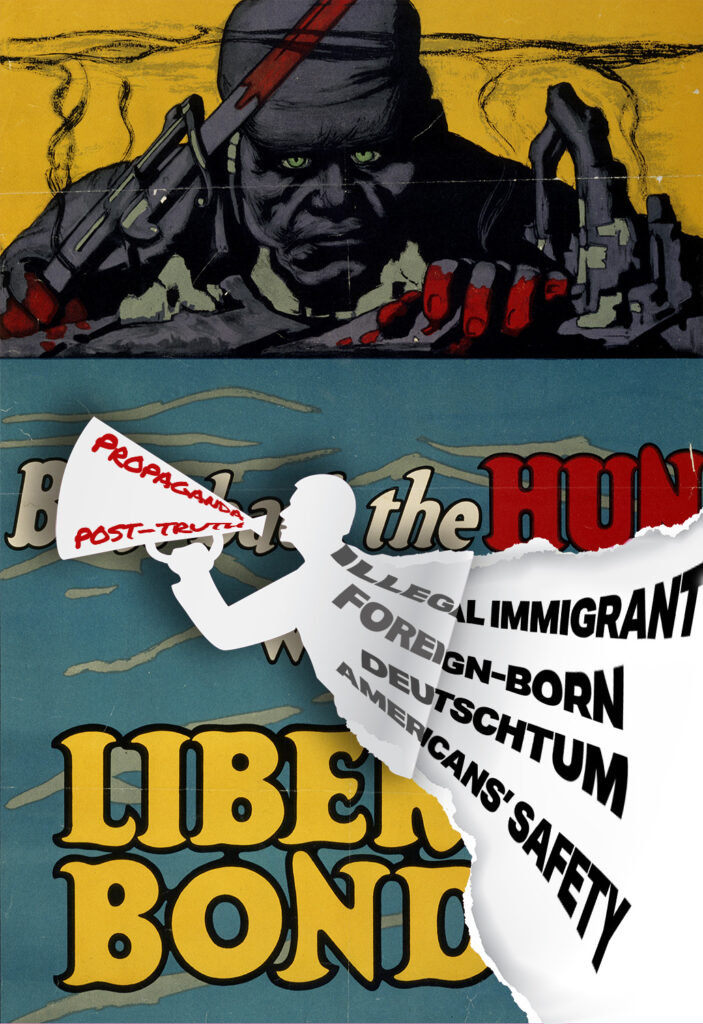Donald Trump will likely go down as one of America’s greatest propagandists. That was one of the conclusions from my podcast analyzing propaganda versus post-truth.

The first time I heard of “post-truth” the idea stuck in my brain. As a professional communicator who’s studied political communication theories, and a former newspaper editor who spent much of his time reporting on municipal, provincial, and federal Canadian politics, I was extremely interested in the idea.
For the history buffs, American propaganda originally started at the onset of the First World War and I wanted to figure out if post-truth and propaganda were the same, or different, as many academics and reporters were claiming. To do that, I analyzed immigration messages of America’s 45th president, Donald Trump – after all, it was his politics that inspired Oxford Dictionary – and how WWI propaganda affected immigrants in the early 1900s.
The project really became a comparison of effects of propaganda messaging, and the actions of Donald Trump. And it unfolded in a way I didn’t expect. I could go on about this, but I think it’s best if you just check out the podcast and let me know what you think. See below for the Spotify link. Or catch it on Apple Podcasts here.
A fun sidenote, which I couldn’t really use in the podcast, was Stephen Colbert’s discussion around post-truth, or as he liked to call it, “truthiness”. He even goes as far to say he was “pre-enraged”. Hashtag hilarious.
100 years separates the propaganda strategies of George Creel, America’s chairperson of the Committee on Public Information, and the post-truth strategies of Donald Trump, America’s 45th president.
Using immigration as the comparator, this podcast analyzes the tactics of American propaganda during the First World War, and the tactics of post-truth by Donald Trump.
Using speeches by Donald Trump and the words of George Creel, as well as historical analysis, books, peer-reviewed journals, and reporting, I delve into the strategies of both to come up with a conclusion that surprised even myself.
Follow my research and analysis as I journey into the two strategies. Couched under a political communication theory called The Spiral of Silence.
My research:
This Is Not Propaganda: Adventures in the War Against Reality Hardcover – Aug. 6 2019 by Peter Pomerantsev (Author)
Manufacturing Consent: The Political Economy of the Mass Media Paperback – Jan. 15 2002 by Edward S. Herman (Author), Noam Chomsky (Author)
Manipulating the Masses: Woodrow Wilson and the Birth of American Propaganda Hardcover – Oct. 21 2020 by John Maxwell Hamilton (Author)
Poulakidakos, S., Veneti, A., & Fangonikolopoulos, C. (2018). Post-truth, propaganda and the transformation of the spiral of silence. International Journal of Media & Cultural Politics, 14(3), 367–382. doi.org/10.1386/macp.14.3.367_1
Post-Truth Paperback – Feb. 16 2018 by Lee McIntyre (Author)
How we advertised America – 1920 by George Creel
Anand, B. N. (2017, January 5). The U.S. Media’s Problems Are Much Bigger than Fake News and Filter Bubbles. Harvard Business Review. hbr.org/2017/01/the-u-s-media…ws-and-filter-bubbles
Alamillo, R., Haynes, C., & Madrid, R. (2019). Framing and immigration through the Trump era. Sociology Compass, 13(5), e12676. doi.org/10.1111/soc4.12676
Music is from YouTube Studio. No attribution is required. Audio from Donald Trump’s speeches and the audio clip of Paul Harvey’s “Now you know the rest of the story” are used in accordance with the Fair Use and Fair Dealings Acts.
